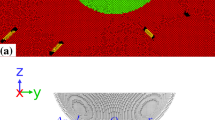Contacts between a clean sodium chloride pyramidal shaped asperity and a plane NaCl surface have been investigated by molecular dynamics simulations. For small contacts, a few atoms across, the asperity jumped to contact and behaved elastically as normal load was applied. Then, when the force was reversed to detach the asperity, brittle failure occurred without any damage to the crystalline materials. However, as the contact size of the asperity was increased to 6 × 6 atoms in area, the mechanism of detachment was seen to alter. The jump to contact was elastic and damage free, but the separation could not be achieved elastically, but required plastic deformation, giving extensive energy dissipation and severe damage as edge defects propagated through the asperity. Above this contact size, plastic flow was dominant. However, there is clearly a further transition back to elastic fracture once the asperity becomes large enough for Griffith-type cracking to propagate above 1 μm in size, since large sodium chloride contacts are known to be brittle above the micrometre scale, depending on the presence of crack initiating defects.




Similar content being viewed by others
References
Tabor D., Winterton R.H. (1969) Proc. R Soc. Lond. A312:435
Israelachvili J.N., Tabor D. (1972) Proc. R Soc. Lond. A331:19
Tabor D. (1977) J. Colloid Interface Sci. 58:2
McFarlane J.S., Tabor D. (1950) Proc. R Soc. Lond. A202:224
Tabor D., Winterton R.H. (1968) Nature 219:1120
Pashley M.D., Pethica J.D., Tabor D. (1984) Wear 100:7
Tabor D. (1959) Proc. R Soc. Lond. A251:378
Landman U., Luedtke W.D., Burnham N.A., Colton R.J. (1990) Science 248:454
Cagin T., Che J., Qi Y., Zhou Y., Demiralp E., Gao G., Goddard W.A. (1999) J. Nanoparticle Res. 1:51
Yong C.W., Smith W., Kendall K. (2002) J. Mater. Chem. 12:2807
Yong C.W., Smith W., Kendall K. (2003) Nanotechnology 14:829
Yong C.W., Kendall K., Smith W. (2004) Phil. Trans. R Soc. Lond. A362:1915
Kendall K. (1978) Nature 272:710
Kendall K. (1978) Proc. R Soc. Lond. A361:245
Kendall K., Yong C.W., Smith W. (2004) J. Adhesion 81:21
W. Smith and T. Forrester, DL_POLY, Version 2.12 (CCLRC, Daresbury Laboratory, UK, 2001)
Kendall K. (2001) Molecular Adhesion and its Applications. Kluwer Academic, New York, pp. 235–237
Roberts R.J., Rowe R.C., Kendall K. (1997) J. Mater. Sci. 32:4183
G.C. Lowrison, Crushing and Grinding (Butterworth, London, 1974) ch.1–5
Author information
Authors and Affiliations
Corresponding author
Rights and permissions
About this article
Cite this article
Yong, C.W., Smith, W., Dhir, A. et al. Transition from elastic to plastic deformation as asperity contact size is increased. Tribol Lett 26, 235–238 (2007). https://doi.org/10.1007/s11249-007-9199-8
Received:
Accepted:
Published:
Issue Date:
DOI: https://doi.org/10.1007/s11249-007-9199-8




